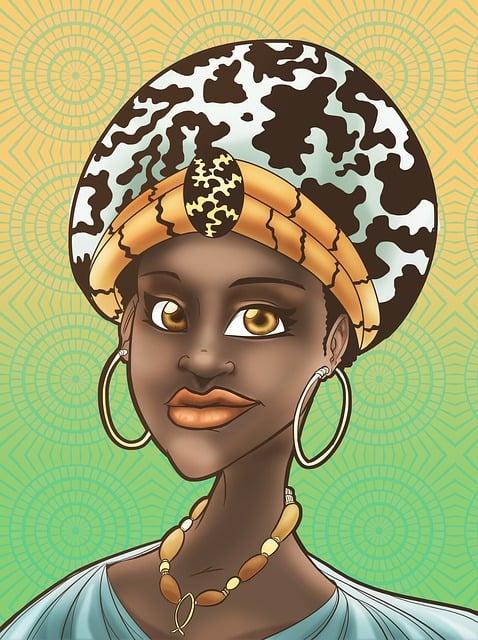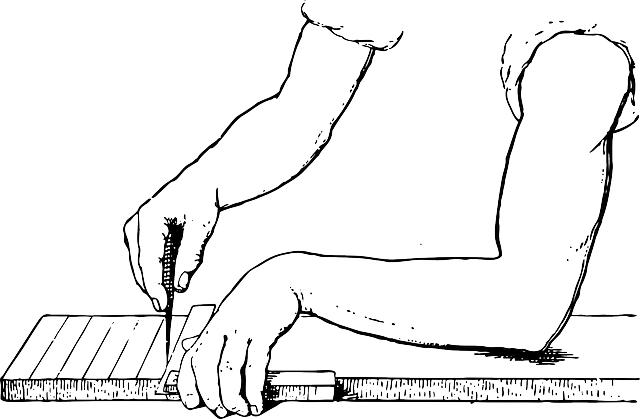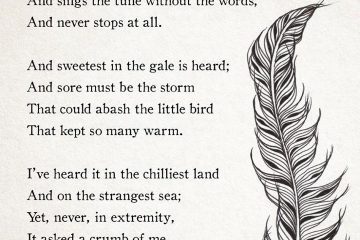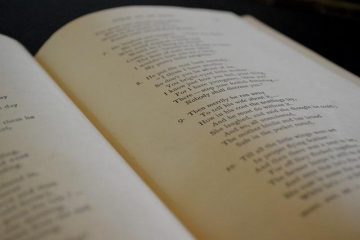Table of Contents
- Exploring the Depths of Dream Imagery in Langston Hughes Poetry
- The Influence of African American Culture on Hughes Dream Themes
- Interpreting Hope and Despair in Hughes Poem Dreams
- Techniques for Analyzing Dream Symbolism in Poetry
- Incorporating Hughes Themes into Your Own Creative Writing
- Q&A
- Concluding Remarks
Exploring the Depths of Dream Imagery in Langston Hughes Poetry
Langston Hughes deftly weaves dream imagery throughout his poetry, transforming abstract aspirations into palpable experiences that resonate deeply with his readers. Dreams, within Hughes’s works, act as both a refuge and a battleground for the African American experience. In his renowned poem “Dreams,” he articulates the fragility of aspirations, urging readers to hold onto their dreams tightly. The poignant imagery presents dreams as essential lifelines, suggesting that the quest for identity and purpose is intricately tied to one’s hopes and visions for the future.
One of the striking aspects of Hughes’s dream imagery is its universality. Through visceral metaphors and vivid descriptions, he transports readers into a world where dreams merge with reality. These dreams often reflect the deep-seated desires and anguishes of a marginalized community striving for recognition and equality. For example, in ”A Dream Deferred,” Hughes delves into the consequences of neglected aspirations, painting a powerful picture of dreams that wither away, suggesting that unfulfilled dreams can lead to a loss of identity and vitality:
- “Does it dry up like a raisin in the sun?”
- “Or fester like a sore?”
- “Does it stink like rotten meat?”
This evocative imagery resonates with the struggles faced by many, making Hughes’s poetry a mirror that reflects the complexities of human emotion. The tension between hope and despair in his works invites readers to explore the rich symbolism and stark realities of dreams. Hughes’s ability to encapsulate such profound themes within simple yet striking imagery makes his poetry not just a reflection of personal experience, but a broader commentary on social injustices and the pursuit of dreams, inviting endless interpretations and connections.


The Influence of African American Culture on Hughes Dream Themes
Langston Hughes masterfully captured the essence of African American culture through his exploration of dreams in his poetry. His works reflect the rich tapestry of experiences, struggles, and aspirations that define the lives of African Americans. Hughes often intertwined the themes of dreams with the cultural heritage of African Americans, drawing on elements such as spirituals, folktales, and oral traditions. This cultural foundation helped shape his perspective on dreams, which served as a symbol of hope and resistance against oppression.
In Hughes’ poems, dreams represent a powerful vehicle for expressing the collective experiences of African Americans. He delves into the struggles faced by his community, encapsulating emotions of pain, yearning, and resilience. These dreams are often portrayed as a means of coping with social injustices and economic hardships. For instance, in pieces like “I Dream a World,” Hughes emphasizes the desire for a brighter future where equality and freedom prevail, encouraging readers to reflect on the duality of dreams—both as aspirations and as mirrors of current reality.
Furthermore, Hughes’ use of vivid imagery and rhythmic language enhances the connection between African American culture and the theme of dreams. His incorporation of cultural references—ranging from ancestral legacies to jazz influences—invites readers to engage deeply with his vision. By employing familiar motifs, he not only resonates with his audience but also celebrates the strength derived from community and shared history. Such artistic choices underscore dreams as a source of courage and inspiration, urging individuals to pursue their visions despite obstacles.


Interpreting Hope and Despair in Hughes Poem Dreams
Langston Hughes’ poem expertly intertwines the themes of hope and despair, reflective of the African American experience in the early 20th century. Through the allegorical notion of dreams, Hughes emphasizes their vital role in sustaining aspirations and maintaining a sense of identity in the face of adversity. As dreams are portrayed as precious and transformative, they embody the hope of a brighter future. Without these dreams, the possibility of despair looms large, suggesting that abandoning one’s aspirations leads to a lifeless existence.
The stark contrast between hope and despair is further illustrated in the poem’s imagery. When Hughes implores readers to “hold fast to dreams,” he is not merely advocating for optimism; he underscores the necessity of dreams as a life force. Conversely, the depiction of “dreams deferred” presents a haunting image of stagnation and unfulfilled potential. This duality creates a tension that resonates deeply, highlighting how hope, while powerful, can be equally precarious. The strong emotional undercurrent urges readers to recognize the impact of their ambitions and the potential devastation that can arise when those aspirations are pushed aside.
Ultimately, Hughes invites a reflection on the emotional spectrum of human experience. He encourages a nuanced understanding of how dreams act as a bridge between the two extremes. The poem serves as a poignant reminder that the pursuit of dreams is not only a source of hope but also a profound motivator that shapes one’s identity and legacy. Acknowledging both the beautiful and painful aspects of this journey allows readers to appreciate the complexity of the human condition, fostering a deeper connection to their own aspirations.


Techniques for Analyzing Dream Symbolism in Poetry
In exploring dream symbolism within poetry, one can employ several techniques to unveil deeper meanings and insights. First, it is essential to identify recurring symbols or themes in the poem. Look for elements that resonate personally or culturally. For instance, Hughes’ work often features:
- Nightmares – representing societal struggles and personal fears.
- Light and darkness – symbolizing hope and despair.
- Natural imagery – reflecting emotional states and aspirations.
Secondly, interpreting the emotional tone of the dreams can significantly enhance understanding. Evaluate how the speaker feels in each scenario. Are they anxious, hopeful, or reflective? This can reveal the poem’s underlying message. For example, Hughes often juxtaposes dreams with harsh realities, which can be addressed through a psychological lens. This technique helps readers connect emotionally with the text, asking questions like:
- What does the dream signify in the context of the speaker’s reality?
- How does the emotional tone shift throughout the poem?
Lastly, employing contextual analysis is vital when interpreting symbolic dreams. Investigate the historical and cultural background surrounding Hughes’ poetry. Understanding the Harlem Renaissance and the socio-political climate of the time can provide significant context. This technique may involve examining literary influences or autobiographical elements. Consider the following table to see how different contexts can change the interpretation of dream symbols:
| Context | Symbol Interpretation |
|---|---|
| Historical | Dreams as escapism from systemic oppression |
| Personal | Individual hopes for a better future |
| Cultural | Collective identity and struggle against injustice |


Incorporating Hughes Themes into Your Own Creative Writing
Langston Hughes eloquently captures the essence of the human experience through his profound exploration of dreams, identity, and social justice. When incorporating his themes into your own creative writing, start by recognizing the significance of dreams in your narrative. Dreams in Hughes’ poetry serve not only as personal aspirations but also as reflections of collective hopes and struggles. Consider weaving a tapestry of personal and societal dreams in your work, exploring how these aspirations clash or harmonize within the characters you create.
Another potent theme in Hughes’s oeuvre is the struggle against oppression and the quest for identity. To echo his resonance, think about how you can bring authenticity to your characters’ voices. Reflect on the cultural, historical, and emotional dimensions that intersect in their lives. Here are some ideas to consider:
- Research historical contexts that relate to your characters.
- Explore the dualities of personal aspirations versus societal expectations.
- Use imagery and rhythm to enhance the emotional weight of your narrative.
the interplay between hope and despair is a recurrent motif in Hughes’s work. In your writing, you may want to create contrasting moments of joy and pain, illustrating the complexity of human emotions. Emphasizing this duality can be powerful. Consider employing a simple table to outline these contrasts:
| Emotion | Manifestation in Writing |
|---|---|
| Hope | Characters strive for a better future, filled with light and vibrancy. |
| Despair | Intense moments of realization, darkness, and the weight of dreams unfulfilled. |
Incorporating these themes into your work offers profound layers, allowing readers to reflect on their own dreams and realities. Through Hughes’s lens, we find the courage to embrace complexity and ignite meaningful conversations in our writing.




0 Comments